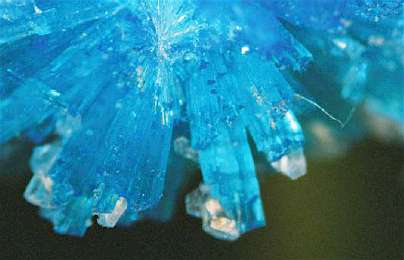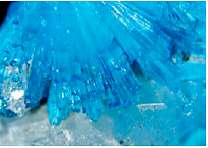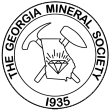Cavansite
by
Dave Babulski, Ed.D.
("Tips and Trips", Vol. XXXIV/three, March 2005, page 6.)

This month we will investigate the mineral CAVANSITE. As mineral species go, cavansite is a relative newcomer, being officially recognized as a mineral species in 1967. The type locality is the Owyhee Dam, Lake Owyhee State Park, Malheur County in Oregon. The host rocks in this area are Miocene volcanics consisting of massive rhyolite and andesite. The cavansite occurs as minute, rather unimpressive, crystals in gas cavities in the volcanic rocks. As this mineral occurrence was rather unimpressive, cavansite was relegated to the status of a mineral curiosity until the early 1970's when the mineral was discovered in the Deccan trap basalts in the Poona district in India. At this locality, cavansite occurs as well developed spherical aggregates of deep blue crystals associated with large crystals of stilbite in gas cavities in the basalt. This mineral occurrence created a sensation in the mineral collecting world. At mineral shows these days it is not uncommon to see rather awesome large specimens of stilbite festooned with spherical groups of deep blue cavansite from the Poona, India locality. The name of this mineral is derived from its chemical composition of calcium, vanadium and the silicate radical. The deep blue color is a result of the vanadium content. Good micromounts of cavansite from the Poona, India locality are very hard to find. You have to break down some thumbnail size specimens to get at the "Good Stuff". The "Good Stuff" is relatively open radiating clusters of deep blue transparent crystals that occur in the void areas between large crystals of stilbite. Shown below are some photomicrographs of some of the "Good Stuff" extracted from thumbnail size specimens purchased from dealers at the December GMS show. Magnification is 25X. An interesting aspect that micromounters have is a visual examination of change in the intensity of color as the vanadium content in the mineral varies. Pale blue crystals with deep blue tips are just awesome things to look at. An examination of the recent mineralogical literature indicates that most geologists agree that vanadium in cavansitecomes from the host volcanic rocks. Reports of vanadium content as high as 600 to 750 ppm in the basalts near Poona have been presented by several geologists working in the area. Another interesting observation is the sequence of mineral deposition. Stilbite appears to have been deposited first, followed by cavansite. In some cases a third depositional phase of heulandite or calcite is observed as tiny crystals deposited on crystals of cavansite. All in all, some superb micromounts can be had by having the courage to break down thumbnail size material. I for one will be looking for some good thumbnail size specimens of cavansite at the upcoming spring gem and mineral show. There is a real thrill when you break down a larger specimen and find some of the "Good Stuff". Until next month, may all your skies be blue and all the vugs you find are crystal filled.


Copyright © Georgia Mineral Society, Inc.
